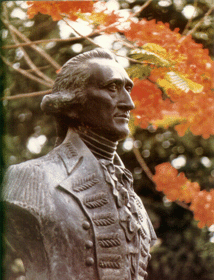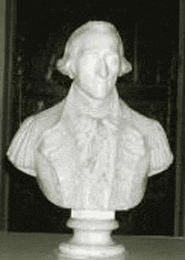
 |
Born
at Lyon, France in 1735, Claude Martin was the son of
a cooper. At the age of sixteen, he enlisted in the
French army and arrived in India in 1752 to begin his
military career. After the Siege of Pondicherry he could
foresee the end of French hopes in India and threw in
his lot with the English. It was a sound choice as undeterred
by early setbacks and by virtue of his numerous skills
and qualities, Martin rose to the rank of Major-General
and amassed a vast fortune.
Claude Martin was indeed
a remarkable man. Besides his abilities as a soldier,
he was much else. He was an outstanding surveyor, and
Rennel made him his deputy for preparing the first authentic
and scientific maps of a region extending from Assam
to Oudh. While in Oudh, he attracted the attention of
Asaf-ud-daula, the Nawab-Vizir, who asked the governor
general for the loan of Martin’s services. Being totally
devoid of political ambition, Claude Martin became a
close confidante of the Nawab-Vizir and a power behind
the scenes. He spent the remainder of his life at Lucknow
where by a mixture of skill, hard work and good fortune,
he became the richest European in Lucknow, so rich the
he was able to lend 250,000 pounds to Nawab Asaf-ud-daula.
|
During the twenty-four years that he
spent at Lucknow his genius flowered. He was in-charge of
the state arsenal, the site on which Raj Bhawan stands today.
He also manufactured cannon, ammunition, bells and coins.
A self-taught architect, he designed and constructed several
outstanding buildings, some of which, including the Chattar
Manzil and Bibiapur Kothi can still be seen in Lucknow.
Perhaps the grandest of all the buildings designed by him
is “Constantia”, which is now over 200 years old. Historians
believe that the name “Constantia” was derived from Martin’s
motto “Labore et Constantia”, which is engraved over one
of the balconies of the building. But romantic people like
to think that it was named after his first love, Constance,
whom he left behind in France when he came to India to seek
his fortune. “Constantia”, his country house and tomb at
Lucknow, is a curious building in a blend of styles which
compulsively draws attention to itself. It has been described
as “a wedding cake in brick”, a “Gothic castle” and a “baroque
folly”. It is this building which forms the focal point
of La Martiniere, Lucknow.
Claude Martin possessed one
of the shrewdest minds of his day, as well as a range of
interests which enabled him to indulge in several key activities
within early colonial India. Besides being an architect
and a surveyor, he farmed indigo and had a banking system.
He experimented with hot-air balloons and bladder surgery.
He was an entrepreneur botanist and patron of the arts,
whose house in Lucknow became a centre for learned discussion.
He advised the British as well as the Nawabs of Oudh on
financial and political matters and in the process amassed
a vast fortune. It is, perhaps, for his philanthropy that
he is best remembered today. His bequests are still alive
in the form of the schools which he endowed at Calcutta,
Lucknow in India and at Lyon in France.
|
|
Of all
European adventurers in India, Claude Martin is singular
in that he left the greater part of his wealth to a
variety of charities. Being almost entirely self-educated,
he realised the value of formalised education and set
aside a vast portion of his estate for the founding
of schools at Calcutta, Lucknow and Lyon (France), the
city of his birth. All these schools are flourishing,
training the youth of today to become educated, disciplined
and useful citizens. Thousands who have passed through
these schools have cause to be grateful for Claude Martin’s
generosity and foresight.
Unfortunately, Claude Martin
has been largely ignored by history. However, historians
are only human and human beings make mistakes. There
could be no other reason why Claude Martin is treated
so unfairly. Lesser people find a place in history books
but historians seem to have neglected the man whose
palace dominated the skyscape of Awadh. French historians
might be embarrassed to acknowledge him because he crossed
over to the English side and English historians side-lined
him because they might not have wanted to give much
credit to a man who, till the end, remained a foreigner
to them. However, wrongs have to be righted. Facts have
to be brought to light.
|
 |
History
has to acknowledge Claude Martin’s contribution so that
he may be given the rightful place he deserves. Few
bothered to look beyond the basic facts that he was
a Frenchman, apparently a soldier of ‘Fortune’, who
amassed fabulous wealth. What they overlooked, or did
not know, is that he was a brave soldier who always
came forward to render military service and ultimately
rose to the rank of Major-General (though honorary)
at a time when foreigners did not rise above the rank
of Major. What odds he must have faced! One can only
marvel at his tenacity and single-mindedness in achieving
his goals.
His services as a surveyor
of places like Undwanala, Chunargarh, the Course of
the River Teesta, and Cooch Bihar were invaluable. The
fact that the East India Company included his maps in
the Bengal Atlas without any change is a strong testament
to their perfection.
He was indeed a perfectionist.
This is manifested in his buildings which had all the
amenities, in which minute attention was given to such
details as defence, cooling and utility. The Nawabs
of Awadh acknowledged Martin as a great architect and
had many of their buildings designed by him.
His servants completed the
wings of `Constantia’ after his death. This goes to
show that he could evoke great loyalty amongst those
who worked for him.
He was the trusted confidante
of the Nawab Asaf-ud-Daula, who saw in Martin a genius,
essential to offset Company influence. Martin too, needed
Asaf-ud-Daula to keep alive his bargaining position
with the Company. The Company needed him, otherwise
he could not have lasted in their service for so long
(1763-1800 A.D.).
As a diplomat he was exemplary.
He walked the tight rope between the Nawab and the Company
with such astuteness that both needed his services till
the end. What a towering personage he must have been
to live amidst suspicion and still keep his head above
water.
He was a money-lender and banker who was trusted more
than the Company or the Nawabs. Such credibility ensured
that a shrewd businessman like him could turn all his
ventures into profitable enterprises.
He was a man of fine taste
who gave Lucknow many of its famous historical buildings.
He was a man who left his
wealth for the children and people of the country which
had become his home for better or for worse.
Even if historians have been
unjust to him, he will remain alive in the hearts of
students who will sing his constant praises. He needs
no elaborate defence. The three schools at Lucknow,
Calcutta and Lyons stand testimony to the sincerity
of his intent – they are his most permanent and eloquent
monument. No history of Lucknow can be complete without
a mention of Claude Martin. He is entitled to a place
of honour for his role in the promotion of education
in India and in his hometown, Lyon.
‘‘ All his martial
deeds may die,
Lasting still his charity;
This his laurel blooms for aye,
Dead, he lives in us today. ``
|
 |
————————————————————————————————————
|